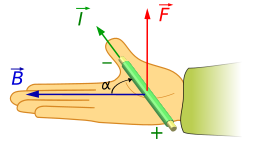Magnetic Force
Magnetic Force
It is observed that a charge \(q\) moving at a velocity \(\textbf{v}\) in a particular field, named as magnetic field \(\textbf{B}\), will be exerted a force, given by $$ \textbf{F} = q\textbf{v} \times \textbf{B} $$ so gerneraly, $$ \bbox[5px,border:2px solid #666] { \textbf{F} = \int dq(\textbf{v} \times \textbf{B}) } $$ This is called the magnetic force. As magnetic force is always perpendicular to the direction the charge moves, it does no work on it $$W = \int \textbf{F}_{mag} \cdot d\textbf{l} = \int q(\textbf{v} \times \textbf{B}) \cdot \textbf{v} dt = 0$$Current
Current is defined as the rate of change of charge $$ \bbox[5px,border:2px solid #666] { I = -\frac{dq}{dt} } $$ The minus sign is to indicate it is the charge leaving we are considering. So, one may express magnetic force in terms of current. Let \(l_{\parallel}\) be the displacement parallel to the charges travel \begin{align} I &= -\frac{dq}{dt} \\ &= -\frac{dq}{dl_{\parallel}}\frac{dl_{\parallel}}{dt} \\ Idl_{\parallel} &= vdq \\ Id\textbf{l} &= \textbf{v}dq \\ \end{align} Magnetic force is then $$F = \int dq(\textbf{v} \times \textbf{B}) = \int Id\textbf{l} \times \textbf{B}$$A rectangular loop of wire, supporting a mass \(m\), hangs vertically with one end in a uniform magnetic field \(\vec{B}\), which points into the page in the shaded region. What was the work done in this process?
Solution: When the loop starts to rise, the charges have an additionaly upward component \(u\) along with the horizontal component \(w\). Let $$I=\lambda w$$ Force acted on the upper segment of the loop is $$F_{vert}=\lambda a \omega B=IBa$$ $$F_{horiz}=quB=\lambda auB$$ The work done by a agency (battery/generator) on the charges to make them to move a horizontal distance \(wdt\) in a time \(dt\) is $$W_{\text{battery}}=\lambda aB\int uw dt = IBah.$$ Thus, we see that the work done on the mass stored as potential energy is actually done by the electrical force that drove the charged particles to move in the wire. The electrical energy was converted to gravitational potential energy.
As the magnetic force is perpendicular to the charges velocity, the work done by the magnetic force is zero.
A square coil with length \(l\) and current \(I\) is flipped an angle \(\pi\) by uniform magnetic field along x-direction. Find the work done in the process.
First, the work done by the magnetic field in rotating the coil. The magnetic dipole moment is given by $$\mu = I a = Il^2.$$ The torque by the magnetic force on the coil is given by $$\tau = 2\left(BIl\left(\frac{l}{2}\right)\sin\theta\right)=\mu B\sin\theta.$$ Then, the work done is \begin{align} W_{\text{rot}} &= \int^0_{\pi}\tau d\theta \\ &= \int^0_{\pi}\mu B \sin\theta d\theta \\ &= \left[ \mu B \cos\theta \right]^0_{\pi} \\ &= 2\mu B \end{align}
Second, the work done by the magnetic field along the current flow direction. Let \(\omega\) be the angular velocity of the rotation of the coil, \(\lambda\) be the charge density of the coil, and \(w\) be the speed of the charge carrier in the coil. The magnetic force along the current direction is $$F_{//}=qvB\sin\theta.$$ The current is expressed as $$I = \lambda w,$$ so the charge, \(q\), in the wire is $$q=\lambda l.$$ As it is a circular motion, the speed, \(v\), is $$v=\omega r.$$ The distance travelled of the charge carrier is the speed multiplied by the duration of rotation $$w\int dt = w\int\frac{1}{\omega}d\theta.$$ The work done on the current in wire is \begin{align} W_{\text{current in}} &= \int \vec{F}_{//}\cdot d\vec{l}\\ &= w \int^\pi_0\frac{qvB\sin\theta}{v/(l/2)}d\theta\\ &= w\int^\pi_0\frac{\lambda l^2}{2}B\sin\theta d\theta \\ &= \left[w\left(\frac{\lambda l^2}{2}\right)B\cos\theta\right]^\pi_0\\ &= -(\lambda l^2w)B\\ &= -\mu B. \end{align} Then, the work done on both current in and current out is $$W_{\text{cur}} = -2\mu B.$$
Hence, the total work done by the magnetic force is zero.
To maintain the charge carrier's constant speed \(w\), the electric force should be equal in magnitude but opposite direction to the magnetic force along the current direction. Thus, work done by the electric force along the current direction is \(2\mu B\). Therefore, the rotational work done in rotating the coil is actually drawn from the work done by the electric force.
Surface Current Density
Consider a sheet of flowing charges \begin{align} dq &= -\sigma da \\ -Idt &= -\sigma da \\ &= \sigma dl_{\bot}dl_{\parallel} \\ dI &= \sigma (\frac{dl_{\parallel}}{dt})dl_{\bot} \\ d\textbf{I} &= \sigma \textbf{v} dl_{\bot} \\ \end{align} Define surface current density \(\textbf{K}\) as $$ \bbox[5px,border:2px solid #666] { \textbf{K} = \frac{d\textbf{I}}{dl_{\bot}} = \sigma \textbf{v} } $$ Hence, magnetic force acting on the sheet in magnetic field \(\textbf{B}\) is \begin{align} \textbf{v}dq &= \frac{\textbf{K}}{\sigma}dq \\ &= \textbf{K}da \\ \textbf{F} &= \int dq (\textbf{v} \times \textbf{B}) = \int (\textbf{K} \times \textbf{B}) da \\ \end{align}Volume Current Density
Consider a volume of flowing charges \begin{align} dq &= -\rho d\tau \\ -Idt &= -\rho d\tau \\ &= \rho da_{\bot}dl_{\parallel} \\ dI &= \rho (\frac{dl_{\parallel}}{dt})da_{\bot} \\ d\textbf{I} &= \rho \textbf{v} da_{\bot} \\ \end{align} Define surface current density \(\textbf{J}\) as $$ \bbox[5px,border:2px solid #666] { \textbf{J} = \frac{d\textbf{I}}{da_{\bot}} = \rho \textbf{v} } $$ Hence, magnetic force acting on the sheet in magnetic field \(\textbf{B}\) is \begin{align} \textbf{v}dq &= \frac{\textbf{J}}{\rho}dq \\ &= \textbf{J}d\tau \\ \textbf{F} &= \int dq (\textbf{v} \times \textbf{B}) = \int (\textbf{J} \times \textbf{B}) d\tau \\ \end{align}Suppose the current density in the wire is proportional to the distance from the axis, $$J=ks,$$ for some constant \(k\). Find the total current in the wire.
Solution:
Current in the shaded patch is $$Jda_{\perp} = Jsdsd\phi$$ So, \begin{align} I&=\int(ks)(sdsd\phi)\\ &=2\pi k\int^a_0s^2ds\\ &=\frac{2\pi ka^3}{3} \end{align}
A current \(I\) flows down a wire of radius \(a\). If it is distributed in such a way that the volume current density is inversely proportional to the distance from the axis, what is \(J\)?







Comments
Post a Comment